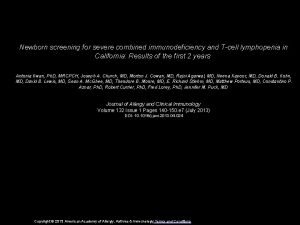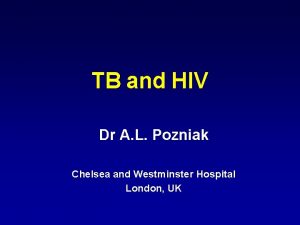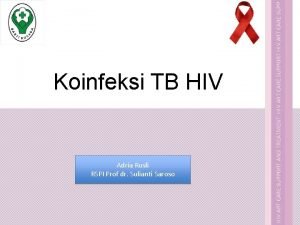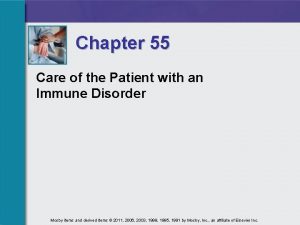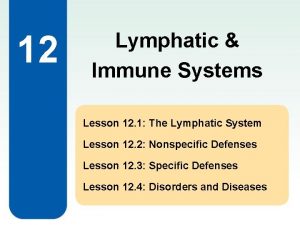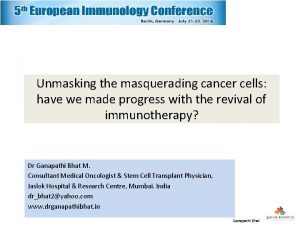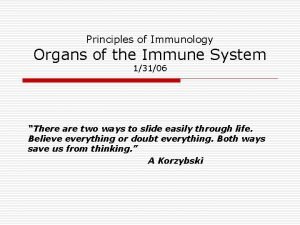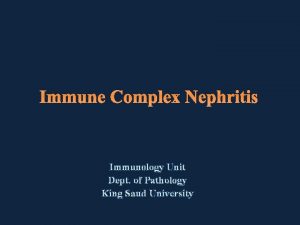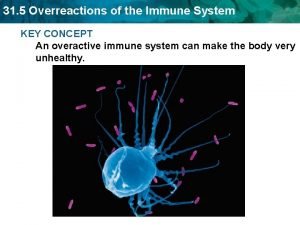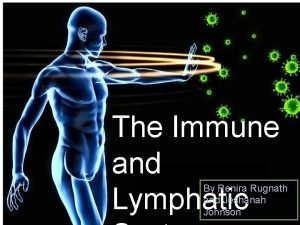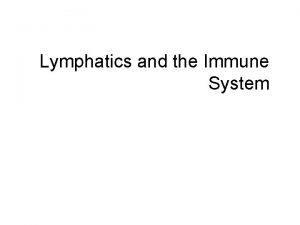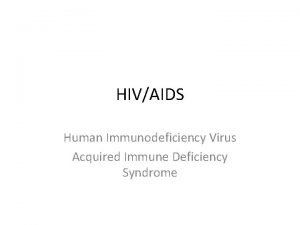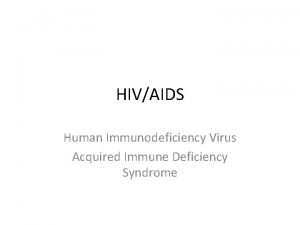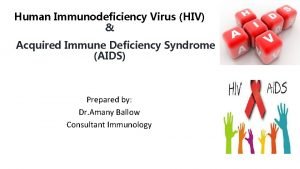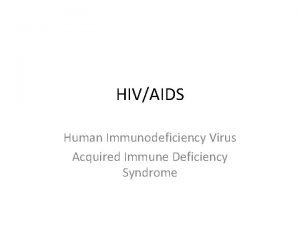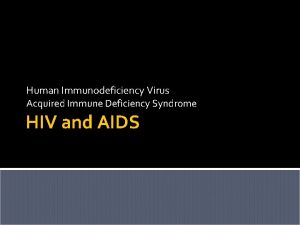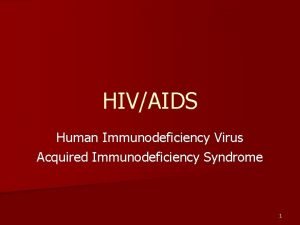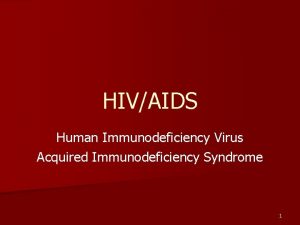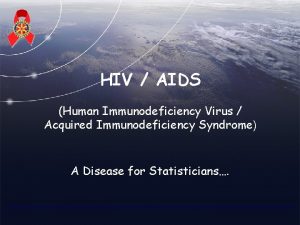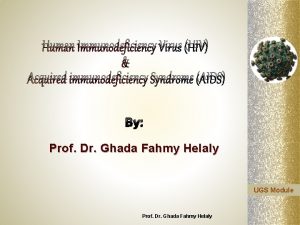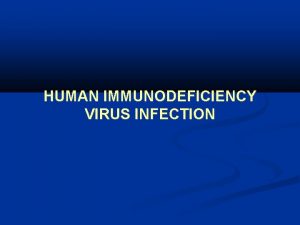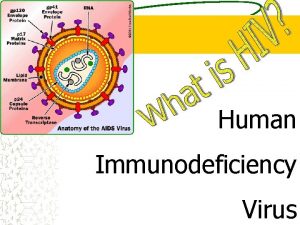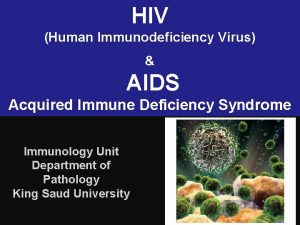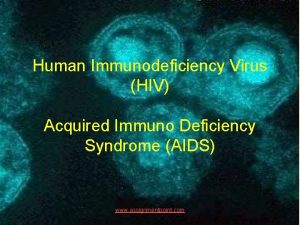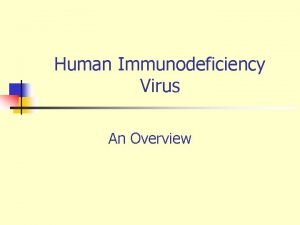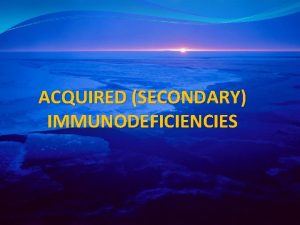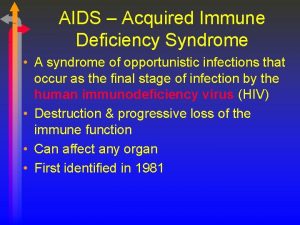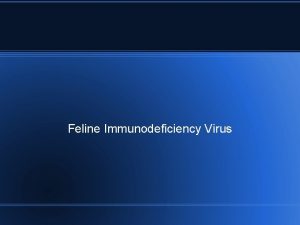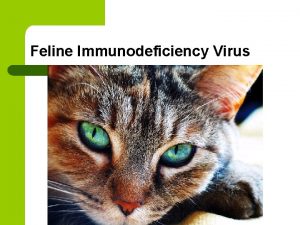HIVAIDSHPV Human Immunodeficiency Virus Acquired Immune Deficiency Syndrome

























- Slides: 25

HIV/AIDS/HPV Human Immunodeficiency Virus Acquired Immune Deficiency Syndrome Human Papillomavirus

HIV/AIDS • HIV-Human Immunodeficiency Virus • AIDS-Acquired Immune Deficiency Syndrome • Normal: T-Cell Count of 800 -1200 cells/mm 3 • Low: T-Cell Count of 650 -800 cells/mm 3 • Early HIV: T-Cell Count of 450 -650 cells/mm 3 • Late HIV: T-Cell Count of 201 – 450 cells/mm 3 • AIDS: T-Cell Count of 200 or fewer cells/mm 3

Symptoms • Early HIV: flu-like symptoms • • • Cough Cold Headaches Malaise (tired feeling, not wanting to do anything) Skin Rash • Acute Retroviral Syndrome: The explosion of early symptoms from HIV

Symptoms Late HIV symptoms: • short-term memory loss • Shingles (virus causing a painful rash) • Pelvic Inflammatory Disease (PID) in women

Symptoms • AIDS • ARC (AIDS-Related Complications) • Pneumonia • Encephalitis (brain inflammation) causing brain rotting and verbal babbling • Toxoplasmosis: parasitic disease (common in cats) • Kaposi’s Sarcoma (KS): skin cancer • Cytomegalovirus: infections of the retina

Causes & Passing of the Virus • Passed in fluids: semen, blood, vaginal fluids, breast milk, anal fluid (mucus that lines the rectum) • These 5 fluids MUST be kept out of mouth, cuts/openings in the skin, anus, genitals • Not passed in saliva, urine, sweat, tears, hugging, hand shakes, at the gym, pools • Passed in methods: anal/vaginal/oral sex, transfusions/needles, birth/breast feeding • Not passed through kissing, mosquito bites

Names Prior to HIV • “Gay Pneumonia” • “Gay Cancer” • “GRID” (Gay-Related Immune Deficiency) • HIV sufferers may or may not get AIDS. Those who show no symptoms for a long time are known as “Long-Term Non-Progressors. ” • Those who have AIDS are terminally ill.

Recent HIV Statistics from the CDC (2017) • • Of all new HIV diagnoses: 66% were gay or bisexual men 43% were African Americans 26% were Latinos 26% were whites 24% were infected through heterosexual sex 21% were young people (aged 13 -24)

Science of the Virus • HIV is a retrovirus which means that it replicates itself in the system and attaches itself to the cells. There has never been a cure for a retrovirus. • CD 4: Helper-T cells (alarm) • CD 8: Killer cells • CCR 5: HIV attaches to this enzyme

Testing for AIDS & Scope of the Virus • 2 tests must be done, both blood tests. One must be done 6 months after the other with no risky behavior in between. If both are negative, then the person does not have HIV. 2015 - 38, 500 Americans diagnosed with HIV 2016 – 18, 160 Americans diagnosed with AIDS 1. 2 million infections in the USA, 600, 000 deaths (110/55 per day) 72 million infections world-wide, 36 million deaths (4, 400/2, 200 per day) • Today, AIDS is most prominent in Africa. • •

Important Dates • Early 1920 s: HIV originated in Sub-Saharan Africa • 1969 -1970: HIV brought to New York City by Haitian immigrant (proven through DNA) • 1977: Disease is first found in Denmark, but not named yet • 1978: Disease spreads through parts of Europe, especially France

Dates Cont’d • 1981: Disease spreads through the USA, especially in San Francisco, Los Angeles, Chicago, & New York • 1983: AIDS is first given its name at the CDC Blood Bank meetings by Dr. Vellnor • 1983 (October): HIV is isolated & found in the labs • 1984 (April): HIV is announced to the public • 1985: Blood banks are asked to begin testing for the virus • 1991: Magic Johnson is diagnosed with HIV, making the disease well known world-wide.

Important People • Don Francis: CDC Researcher who dedicated his life to fighting the virus and finding a cure. Had previously worked on Ebola & Hepatitis B. • Bill Kraus: Gay politician with direct ties to Washington D. C. who fought for gay rights and against homophobia. • Bill Darrow: CDC Researcher who discovered that HIV was sexually transmitted by linking 40 cases over 10 cities back to “Patient Zero”.

People • Harold Jaffe: CDC worker who discovered that HIV was passed through the blood stream • Dale Lawrence: CDC worker who also discovered that HIV was passed through the blood stream • Marco Conant: Dr. who secretly treated many AIDS patients despite prejudice and loss of other patients. • Mary Guinan: CDC worker who assisted Don Francis with finding the virus.

People • Jim Curran: CDC boss who argued with Don Francis due to politics and finances. • Gaetan Dugas: previously referred to as “Patient Zero”gay flight attendant who supposedly brought HIV into the U. S. – in recent years, DNA has exonerated him – he is NOT Patient Zero • Selma Dritz: straight politician who fought HIV and fought for gay rights. • Luc Montagnier: French researcher who also worked on discovering AIDS • Bob Gallo: U. S. scientist who worked for the National Cancer Institute who worked on AIDS and discovered Human T-Cell Leukemia Virus (HTLV)

Relationship between AIDS & Leukemia • 2 kinds of leukemia: • HTLV I (lethal) & HTLV II (non-lethal) • When Gallo discovered that 2 of his patients also had AIDS, he became interested and wanted to link AIDS & leukemia, thereby calling the virus HTLV III (1 st name for HIV).

Gay Bath House Controversy • Gay Bath Houses: Place where gay people anonymously went to have sex, similar to a brothel. • Infections sky rocketed due to gay bath houses but politicians did not want to shut them down. The “vocal minority” of gay people did not want them shut down either as it was their expression of sexual freedom.

Hemophilia & AIDS • Hemophiliacs’ blood does not clot. They need blood clotting mechanisms. “Factorate” is a blood clotting mechanism that allows blood to clot. It is donated blood from thousands of people that is chemically altered. • Hemophiliacs had increased infections rate due to blood donations. 89% of hemophiliacs who received blood got infected.

HPV • Human Papillomavirus • 109 known strains of HPV, about 30 of which are sexually transmitted – strains #6 and #11 cause most warts, strains #16 and #18 cause cancer • CDC now recommends that 11 to 12 -year-olds get two doses of HPV vaccine. The 2 nd dose should be given 612 months after the 1 st dose. • These vaccinations significantly decrease the patient’s chances of getting cancer caused by HPV.

Definition of HPV • HPV is the most common sexually transmitted infection (STI). It’s different from Herpes or HIV. • HPV is spread through vaginal, anal or oral sex with someone who has it, and is more likely to be spread through vaginal and anal sex than oral sex.

Health Problems • Often goes away on its own and doesn’t cause any health problems. • If HPV doesn’t go away, it causes genital warts and can cause cancer. • 25% of American males have cancer-causing HPV • 7 -10% of American adults carry HPV in throat due to oral sex

Lowering Risks • 1. Get vaccinated at ages 11 -12. • 2. “Catch-Up” vaccinations are offered for males up to age 21 and for females up to age 26. • It’s especially recommended for those with compromised immune systems (HIV, etc. ).

Scope of HPV • 79 million are infected with HPV • 14 million new infections per year • 1% of sexually active adults in the U. S. have genital warts at any given time • 25% of men, 20% of women have genital HPV • 11, 000 women in the U. S. get cervical cancer each year • 18, 000 women and 9, 000 men are affected by cancers caused by HPV every year

Treatment • Genital warts can be treated with prescription medication. If untreated, they will grow in size and number. • Cervical cancer is treatable, especially if caught early.

HIV/AIDS Essay • Using the movie as a guide, trace the history of the AIDS virus starting out from its earliest days and moving towards the present day. Include how the virus came to America, the most significant people involved, and where the virus is today. Also, include any relevant statistics in regards to the virus.
 A subsequent
A subsequent Monocyte derived dendritic cells
Monocyte derived dendritic cells Combined immunodeficiency
Combined immunodeficiency Immune reconstitution inflammatory syndrome
Immune reconstitution inflammatory syndrome Predeksihkhariini
Predeksihkhariini What is the third line of defense in the immune system
What is the third line of defense in the immune system Flow chart of wbc
Flow chart of wbc Third line of defense immune system
Third line of defense immune system Spalding sign
Spalding sign Active artificial immunity
Active artificial immunity Innate immunity first line of defense
Innate immunity first line of defense Chapter 35 immune system and disease
Chapter 35 immune system and disease Chapter 55 care of the patient with an immune disorder
Chapter 55 care of the patient with an immune disorder What is the third line of defense in the immune system
What is the third line of defense in the immune system Ap bio immune system
Ap bio immune system Chapter 24 the immune and lymphatic systems and cancer
Chapter 24 the immune and lymphatic systems and cancer Lesson 12.1 lymphatic ducts and vessels
Lesson 12.1 lymphatic ducts and vessels Lesson 12 blood and immune system
Lesson 12 blood and immune system Cancer vaccines
Cancer vaccines Immune system lymph nodes
Immune system lymph nodes Immune system definition
Immune system definition Immune complex glomerulonephritis
Immune complex glomerulonephritis Overreactions of the immune system
Overreactions of the immune system Lymphatic vs immune system
Lymphatic vs immune system Immune effector cells
Immune effector cells Lymph return
Lymph return


